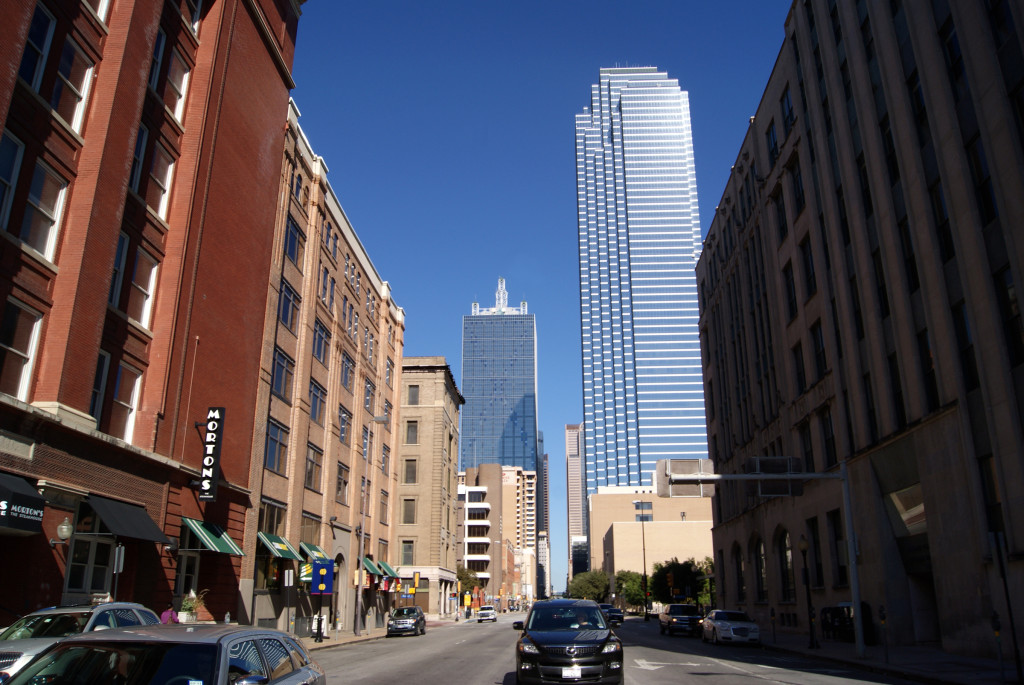From Fort Worth Business Press by Jack Z. Smith
Revenues generated for Fort Worth’s massive Trinity Uptown project by a Tax Increment Financing district, or TIF, are steadily increasing and exceeding projections by nearly 30 percent. This early trend is giving local officials increasing confidence that the Trinity River Vision TIF eventually will provide at least the budgeted amount of $320 million – or more than one-third – of the $909.9 million needed for the controversial flood control and economic development project. The TRV’s chief financial goal is to strengthen the city’s tax base by transforming an old, lackluster 800-acre industrial area just north of downtown into a vibrant new residential and commercial development featuring 12 miles of urban waterfront.
The TRV TIF is still in its early stages and therefore providing only modest revenues. But its revenue stream is projected to soar in future years as a result of a rise in property values and extensive new private development within its nearly 4,000-acre district. Meanwhile, a huge loan commitment from the Tarrant Regional Water District, a major participant in the Uptown project, is being counted on to provide vital up-front funding to keep the project going. TIF revenues for 2014, all devoted to the Uptown project, total $3.12 million, said Avis Chaisson, community development manager for the city of Fort Worth, which also is a key local Uptown participant.
The 2014 TIF revenues are 12.3 percent higher than the 2013 revenues of nearly $2.77 million and 75.4 percent higher than the revenue estimate of $1.78 million for 2014 that was made in 2009. TIF revenue estimates were lowered in that year in the wake of the 2007-2008 U.S. financial crisis. Total TRV TIF revenues, from 2005 through 2014, are $16.21 million. That’s nearly $3.7 million, or 29.5 percent, above the revised projections made in 2009 for that 10-year period. A TIF is an entity, often created by a city, that derives its funding from annual year-to-year gains in local tax revenues, such as property taxes, from a designated geographic area. The TIF revenue is used for designated purposes such as public street, sidewalk, lighting, water and sewer or park improvements that encourage attractive private development and redevelopment, which in turns boosts the tax base and creates more revenues.
Fort Worth City Councilman for District 7 Dennis Shingleton, chairman of the TRV TIF board, said the TIF’s revenue flow is “going very, very well.” Future development in the Uptown area could result in a “greatly enhanced” city tax base in coming decades, he said. Jay Chapa, Fort Worth’s director of housing and economic development, said he is encouraged by the TIF revenue numbers. There are “tons of opportunities” for new development that will significantly boost property valuations within the TIF district and generate more tax revenues for the Uptown project, he said. With downtown having undergone a dramatic renaissance and the West Seventh Street corridor just west of downtown exploding with new residential and commercial development, Chapa said, “it’s just a no-brainer” that similar success can be expected in the 800-acre Uptown redevelopment area that borders the Trinity River. As Uptown blossoms with new development, it likely will have a ripple effect of encouraging redevelopment farther north on the city’s expansive North Side, which includes the historic Stockyards area, Shingleton said. That opinion also was expressed by Fort Worth City Councilman Sal Espino, who represents the North Side and is a board member of the TRV TIF and Trinity River Vision Authority, a water district unit that is helping coordinate the Uptown project.
Espino cites a growing push for quality urban mixed-use development allowing residents to live nearer where they work and play. “I think people want to be close to a world-class downtown. … They want a shorter commute and not having to deal with traffic congestion,” he said. The Uptown area would offer a very short work commute to downtown or the medical district. A new estimate by Downtown Fort Worth Inc. puts downtown employment at 44,755 jobs, said Arrie Mitchell, DFWI director of research. More than 30,000 people work in the medical district, said Paul Paine, president of Fort Worth South Inc. Barbara Becker, a downtown Fort Worth resident and dean of the School of Urban and Public Affairs at the University of Texas at Arlington, said it’s a very good sign that the early TRV TIF revenues are exceeding projections. For a TIF “to have a cushion on the front end is a really good thing,” she said. That can enable a project to move ahead more rapidly and potentially result in some development taking place sooner, she said.
J.D. Granger, TRVA executive director, said the gains in TIF revenues are resulting primarily from new residential and retail development in and near West Seventh Street and the extensive residential development on the Trinity bluffs on the north edge of downtown and overlooking the river. In a single decade, from 2003 to 2013, the taxable value of properties has skyrocketed by more than 360 percent, from $111.4 million to $403.6 million, for a 1,380-acre portion of the TRV TIF district that accounts for the lion’s share of its tax revenues, according to city figures. Uptown backers say the project could trigger the eventual creation of up to 10,000 new residential units and 3 million square feet of commercial development in the area. Numerous old industrial properties already have been acquired for the project and businesses relocated, leaving the target area ripe for urban redevelopment. The next big phase of the Uptown project is the start, perhaps in August or September, of construction on three new bridges that will span a future 1.6-mile bypass channel. Project officials say the channel, along with a hydraulic dam to be built downstream, will provide a more constant water level for the Trinity, enable creation of a 33-acre urban lake and allow removal of some levees that have thwarted waterfront development and public access to the river. The $909.9 million budget outline for Trinity Uptown calls for $320 million to come from the TIF, whose participants include the water district, Fort Worth, Tarrant County, the Tarrant County Hospital District and Tarrant County College District. The budget calls for non-local funding of $487.9 million, including $411.6 million in federal funding for the U.S. Army Corps of Engineers, which is leading the project’s flood-control effort. Thus far, $74.7 million in federal funding has been received for the project, including a recent appropriation of nearly $16.1 million that was mentioned at the April 9 meeting of the TRVA board.
The TIF is funded from incremental year-to-year gains in property tax revenues generated in a 3,980-acre district that includes the 800-acre Uptown area; a portion of the West Seventh area (including the So7 residential and retail development and The Stayton at Museum Way, a big high-rise residential development for seniors); and nearby areas to the north, including the planned Left Bank mixed-use development just east of Montgomery Plaza and fronting on West Seventh, and other locations closer to White Settlement Road. The TIF also includes much of the Trinity River bluffs area on the north edge of downtown, where there has been heavy residential development and more is underway or planned. In conjunction with a major expansion of the Trinity Uptown project in 2009, the TRV TIF area grew from its original 1,380 acres to 3,980 acres with the addition of 2,600 much-less-populated acres primarily east of downtown and along the Trinity River Channel. The expanded portion includes plans for major improvements to Gateway Park, Trinity River ecosystem restoration and the creation of “valley storage areas” to temporarily hold floodwaters during heavy rains.
With the Uptown project greatly expanded and its cost substantially increased, the funding life of the TRV TIF was expanded from 25 to 40 years to produce more revenue. The TIF is scheduled to shut down on Dec. 31, 2044. The TIF’s revenues are projected to mushroom in future years, hitting an annual high of $30.1 million in 2044. The TIF is projected to produce $448 million in revenues over 40 years, but, as with most TIFs, the biggest revenues are expected in its later years. Critics of the Uptown project have labeled it a “billion-dollar boondoggle” that will most greatly benefit private developers. Detractors also have complained of the TIF’s exceptionally long 40-year funding cycle, the fact that only a small fraction of Trinity Uptown project funding has been approved by voters in local elections, and that numerous businesses were pressured to relocate from the area because the water district has the power of eminent domain.
Aside from the TIF funding, the water district is providing a $64.4 million contribution to the project, Fort Worth is providing $26.6 million, and Tarrant County, $11 million. In addition, the water district has agreed to lend up to $320 million to the project interest-free, with the loan balance never to exceed $226 million. The water district is to be paid back from TIF revenues, but it estimates that it won’t be fully paid back until 2035, well after the scheduled completion of Uptown in 2023. The water district already has lent the TRV TIF about $69 million and has been paid back nearly $12.4 million, leaving the outstanding loan amount at $56.6 million. Granger said the water district is providing major funding support aside from the TIF because the water district levies only a two-cent property tax and thus generates far less in incremental tax revenues than other TIF participants. In contrasting, Fort Worth has a property tax rate of 85.5 cents and therefore contributes far more tax money to the TIF. Randy Gideon, a consultant and architect who was a partner in the former Gideon Toal firm that was involved in early planning efforts for Trinity Uptown, said the TIF revenues can be expected to keep growing as the Uptown project progresses. The 800-acre target area will offer private developers the potential for high-density development on sizable tracts of land, he said. “More and more people want to move back into the urban core, and I think that’s what is going to drive it,” he said.
Fort Worth Business Press




